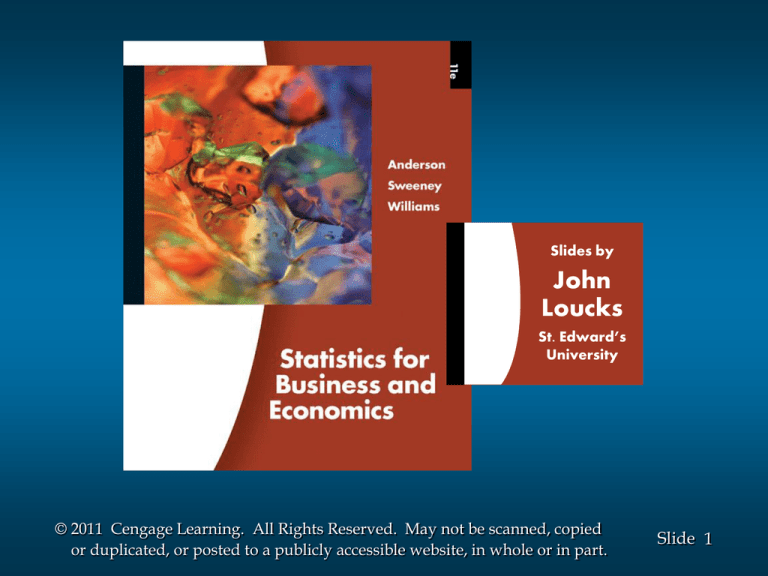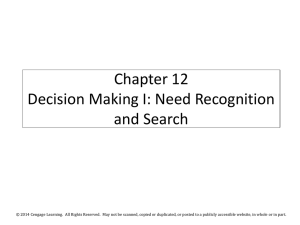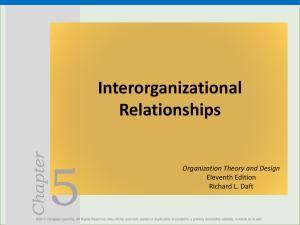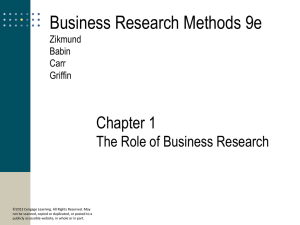
Slides by
John
Loucks
St. Edward’s
University
© 2011 Cengage Learning. All Rights Reserved. May not be scanned, copied
or duplicated, or posted to a publicly accessible website, in whole or in part.
Slide 1
Chapter 9, Part A
Hypothesis Testing
Developing Null and Alternative Hypotheses
Type I and Type II Errors
Population Mean: s Known
Population Mean: s Unknown
Population Proportion
© 2011 Cengage Learning. All Rights Reserved. May not be scanned, copied
or duplicated, or posted to a publicly accessible website, in whole or in part.
Slide 2
Hypothesis Testing
Hypothesis testing can be used to determine whether
a statement about the value of a population parameter
should or should not be rejected.
The null hypothesis, denoted by H0 , is a tentative
assumption about a population parameter.
The alternative hypothesis, denoted by Ha, is the
opposite of what is stated in the null hypothesis.
The hypothesis testing procedure uses data from a
sample to test the two competing statements
indicated by H0 and Ha.
© 2011 Cengage Learning. All Rights Reserved. May not be scanned, copied
or duplicated, or posted to a publicly accessible website, in whole or in part.
Slide 3
Developing Null and Alternative Hypotheses
•
It is not always obvious how the null and alternative
hypotheses should be formulated.
• Care must be taken to structure the hypotheses
appropriately so that the test conclusion provides
the information the researcher wants.
•
The context of the situation is very important in
determining how the hypotheses should be stated.
•
In some cases it is easier to identify the alternative
hypothesis first. In other cases the null is easier.
• Correct hypothesis formulation will take practice.
© 2011 Cengage Learning. All Rights Reserved. May not be scanned, copied
or duplicated, or posted to a publicly accessible website, in whole or in part.
Slide 4
Developing Null and Alternative Hypotheses
Alternative Hypothesis as a Research Hypothesis
•
Many applications of hypothesis testing involve
an attempt to gather evidence in support of a
research hypothesis.
•
In such cases, it is often best to begin with the
alternative hypothesis and make it the conclusion
that the researcher hopes to support.
•
The conclusion that the research hypothesis is true
is made if the sample data provide sufficient
evidence to show that the null hypothesis can be
rejected.
© 2011 Cengage Learning. All Rights Reserved. May not be scanned, copied
or duplicated, or posted to a publicly accessible website, in whole or in part.
Slide 5
Developing Null and Alternative Hypotheses
Alternative Hypothesis as a Research Hypothesis
•
Example:
A new teaching method is developed that is
believed to be better than the current method.
•
Alternative Hypothesis:
The new teaching method is better.
•
Null Hypothesis:
The new method is no better than the old method.
© 2011 Cengage Learning. All Rights Reserved. May not be scanned, copied
or duplicated, or posted to a publicly accessible website, in whole or in part.
Slide 6
Developing Null and Alternative Hypotheses
Alternative Hypothesis as a Research Hypothesis
•
Example:
A new sales force bonus plan is developed in an
attempt to increase sales.
•
Alternative Hypothesis:
The new bonus plan increase sales.
•
Null Hypothesis:
The new bonus plan does not increase sales.
© 2011 Cengage Learning. All Rights Reserved. May not be scanned, copied
or duplicated, or posted to a publicly accessible website, in whole or in part.
Slide 7
Developing Null and Alternative Hypotheses
Alternative Hypothesis as a Research Hypothesis
•
Example:
A new drug is developed with the goal of lowering
blood pressure more than the existing drug.
•
Alternative Hypothesis:
The new drug lowers blood pressure more than
the existing drug.
• Null Hypothesis:
The new drug does not lower blood pressure more
than the existing drug.
© 2011 Cengage Learning. All Rights Reserved. May not be scanned, copied
or duplicated, or posted to a publicly accessible website, in whole or in part.
Slide 8
Developing Null and Alternative Hypotheses
Null Hypothesis as an Assumption to be Challenged
•
We might begin with a belief or assumption that
a statement about the value of a population
parameter is true.
•
We then using a hypothesis test to challenge the
assumption and determine if there is statistical
evidence to conclude that the assumption is
incorrect.
•
In these situations, it is helpful to develop the null
hypothesis first.
© 2011 Cengage Learning. All Rights Reserved. May not be scanned, copied
or duplicated, or posted to a publicly accessible website, in whole or in part.
Slide 9
Developing Null and Alternative Hypotheses
Null Hypothesis as an Assumption to be Challenged
•
Example:
The label on a soft drink bottle states that it
contains 67.6 fluid ounces.
•
Null Hypothesis:
The label is correct. m > 67.6 ounces.
•
Alternative Hypothesis:
The label is incorrect. m < 67.6 ounces.
© 2011 Cengage Learning. All Rights Reserved. May not be scanned, copied
or duplicated, or posted to a publicly accessible website, in whole or in part.
Slide 10
Summary of Forms for Null and Alternative
Hypotheses about a Population Mean
The equality part of the hypotheses always appears
in the null hypothesis.
In general, a hypothesis test about the value of a
population mean m must take one of the following
three forms (where m0 is the hypothesized value of
the population mean).
H 0 : m m0
H a : m m0
H 0 : m m0
H a : m m0
H 0 : m m0
H a : m m0
One-tailed
(lower-tail)
One-tailed
(upper-tail)
Two-tailed
© 2011 Cengage Learning. All Rights Reserved. May not be scanned, copied
or duplicated, or posted to a publicly accessible website, in whole or in part.
Slide 11
Null and Alternative Hypotheses
Example: Metro EMS
A major west coast city provides one of the most
comprehensive emergency medical services in the
world. Operating in a multiple hospital system
with approximately 20 mobile medical units, the
service goal is to respond to medical emergencies
with a mean time of 12 minutes or less.
The director of medical services wants to
formulate a hypothesis test that could use a sample
of emergency response times to determine whether
or not the service goal of 12 minutes or less is being
achieved.
© 2011 Cengage Learning. All Rights Reserved. May not be scanned, copied
or duplicated, or posted to a publicly accessible website, in whole or in part.
Slide 12
Null and Alternative Hypotheses
H0: m
The emergency service is meeting
the response goal; no follow-up
action is necessary.
Ha: m
The emergency service is not
meeting the response goal;
appropriate follow-up action is
necessary.
where: m = mean response time for the population
of medical emergency requests
© 2011 Cengage Learning. All Rights Reserved. May not be scanned, copied
or duplicated, or posted to a publicly accessible website, in whole or in part.
Slide 13
Type I Error
Because hypothesis tests are based on sample data,
we must allow for the possibility of errors.
A Type I error is rejecting H0 when it is true.
The probability of making a Type I error when the
null hypothesis is true as an equality is called the
level of significance.
Applications of hypothesis testing that only control
the Type I error are often called significance tests.
© 2011 Cengage Learning. All Rights Reserved. May not be scanned, copied
or duplicated, or posted to a publicly accessible website, in whole or in part.
Slide 14
Type II Error
A Type II error is accepting H0 when it is false.
It is difficult to control for the probability of making
a Type II error.
Statisticians avoid the risk of making a Type II
error by using “do not reject H0” and not “accept H0”.
© 2011 Cengage Learning. All Rights Reserved. May not be scanned, copied
or duplicated, or posted to a publicly accessible website, in whole or in part.
Slide 15
Type I and Type II Errors
Population Condition
Conclusion
H0 True
(m < 12)
H0 False
(m > 12)
Accept H0
(Conclude m < 12)
Correct
Decision
Type II Error
Type I Error
Correct
Decision
Reject H0
(Conclude m > 12)
© 2011 Cengage Learning. All Rights Reserved. May not be scanned, copied
or duplicated, or posted to a publicly accessible website, in whole or in part.
Slide 16
p-Value Approach to
One-Tailed Hypothesis Testing
The p-value is the probability, computed using the
test statistic, that measures the support (or lack of
support) provided by the sample for the null
hypothesis.
If the p-value is less than or equal to the level of
significance , the value of the test statistic is in the
rejection region.
Reject H0 if the p-value < .
© 2011 Cengage Learning. All Rights Reserved. May not be scanned, copied
or duplicated, or posted to a publicly accessible website, in whole or in part.
Slide 17
Lower-Tailed Test About a Population Mean:
s Known
p-Value < ,
so reject H0.
p-Value Approach
= .10
Sampling
distribution
x m0
of z
s/ n
p-value
7
z
z = -z =
-1.46 -1.28
0
© 2011 Cengage Learning. All Rights Reserved. May not be scanned, copied
or duplicated, or posted to a publicly accessible website, in whole or in part.
Slide 18
Upper-Tailed Test About a Population Mean:
s Known
p-Value < ,
so reject H0.
p-Value Approach
Sampling
distribution
x m0
of z
s/ n
= .04
p-Value
z
0
z =
1.75
z=
2.29
© 2011 Cengage Learning. All Rights Reserved. May not be scanned, copied
or duplicated, or posted to a publicly accessible website, in whole or in part.
Slide 19
Critical Value Approach to
One-Tailed Hypothesis Testing
The test statistic z has a standard normal probability
distribution.
We can use the standard normal probability
distribution table to find the z-value with an area
of in the lower (or upper) tail of the distribution.
The value of the test statistic that established the
boundary of the rejection region is called the
critical value for the test.
The rejection rule is:
• Lower tail: Reject H0 if z < -z
• Upper tail: Reject H0 if z > z
© 2011 Cengage Learning. All Rights Reserved. May not be scanned, copied
or duplicated, or posted to a publicly accessible website, in whole or in part.
Slide 20
Lower-Tailed Test About a Population Mean:
s Known
Critical Value Approach
Sampling
distribution
of z x m 0
s/ n
Reject H0
Do Not Reject H0
z
z = 1.28
0
© 2011 Cengage Learning. All Rights Reserved. May not be scanned, copied
or duplicated, or posted to a publicly accessible website, in whole or in part.
Slide 21
Upper-Tailed Test About a Population Mean:
s Known
Critical Value Approach
Sampling
distribution
of z x m 0
s/ n
Reject H0
Do Not Reject H0
z
0
z = 1.645
© 2011 Cengage Learning. All Rights Reserved. May not be scanned, copied
or duplicated, or posted to a publicly accessible website, in whole or in part.
Slide 22
Steps of Hypothesis Testing
Step 1. Develop the null and alternative hypotheses.
Step 2. Specify the level of significance .
Step 3. Collect the sample data and compute the test
statistic.
p-Value Approach
Step 4. Use the value of the test statistic to compute the
p-value.
Step 5. Reject H0 if p-value < .
© 2011 Cengage Learning. All Rights Reserved. May not be scanned, copied
or duplicated, or posted to a publicly accessible website, in whole or in part.
Slide 23
Steps of Hypothesis Testing
Critical Value Approach
Step 4. Use the level of significance to determine the
critical value and the rejection rule.
Step 5. Use the value of the test statistic and the rejection
rule to determine whether to reject H0.
© 2011 Cengage Learning. All Rights Reserved. May not be scanned, copied
or duplicated, or posted to a publicly accessible website, in whole or in part.
Slide 24
One-Tailed Tests About a Population Mean:
s Known
Example: Metro EMS
The response times for a random sample of 40
medical emergencies were tabulated. The sample
mean is 13.25 minutes. The population standard
deviation is believed to be 3.2 minutes.
The EMS director wants to perform a hypothesis
test, with a .05 level of significance, to determine
whether the service goal of 12 minutes or less is
being achieved.
© 2011 Cengage Learning. All Rights Reserved. May not be scanned, copied
or duplicated, or posted to a publicly accessible website, in whole or in part.
Slide 25
One-Tailed Tests About a Population Mean:
s Known
p -Value and Critical Value Approaches
1. Develop the hypotheses.
H0: m
Ha: m
2. Specify the level of significance.
= .05
3. Compute the value of the test statistic.
x m 13.25 12
z
2.47
s / n 3.2 / 40
© 2011 Cengage Learning. All Rights Reserved. May not be scanned, copied
or duplicated, or posted to a publicly accessible website, in whole or in part.
Slide 26
One-Tailed Tests About a Population Mean:
s Known
p –Value Approach
4. Compute the p –value.
For z = 2.47, cumulative probability = .9932.
p–value = 1 .9932 = .0068
5. Determine whether to reject H0.
Because p–value = .0068 < = .05, we reject H0.
There is sufficient statistical evidence
to infer that Metro EMS is not meeting
the response goal of 12 minutes.
© 2011 Cengage Learning. All Rights Reserved. May not be scanned, copied
or duplicated, or posted to a publicly accessible website, in whole or in part.
Slide 27
One-Tailed Tests About a Population Mean:
s Known
p –Value Approach
Sampling
distribution
of z x m 0
s/ n
= .05
p-value
z
0
z =
1.645
z=
2.47
© 2011 Cengage Learning. All Rights Reserved. May not be scanned, copied
or duplicated, or posted to a publicly accessible website, in whole or in part.
Slide 28
One-Tailed Tests About a Population Mean:
s Known
Critical Value Approach
4. Determine the critical value and rejection rule.
For = .05, z.05 = 1.645
Reject H0 if z > 1.645
5. Determine whether to reject H0.
Because 2.47 > 1.645, we reject H0.
There is sufficient statistical evidence
to infer that Metro EMS is not meeting
the response goal of 12 minutes.
© 2011 Cengage Learning. All Rights Reserved. May not be scanned, copied
or duplicated, or posted to a publicly accessible website, in whole or in part.
Slide 29
p-Value Approach to
Two-Tailed Hypothesis Testing
Compute the p-value using the following three steps:
1. Compute the value of the test statistic z.
2. If z is in the upper tail (z > 0), find the area under
the standard normal curve to the right of z.
If z is in the lower tail (z < 0), find the area under
the standard normal curve to the left of z.
3. Double the tail area obtained in step 2 to obtain
the p –value.
The rejection rule:
Reject H0 if the p-value < .
© 2011 Cengage Learning. All Rights Reserved. May not be scanned, copied
or duplicated, or posted to a publicly accessible website, in whole or in part.
Slide 30
Critical Value Approach to
Two-Tailed Hypothesis Testing
The critical values will occur in both the lower and
upper tails of the standard normal curve.
Use the standard normal probability distribution
table to find z/2 (the z-value with an area of /2 in
the upper tail of the distribution).
The rejection rule is:
Reject H0 if z < -z/2 or z > z/2.
© 2011 Cengage Learning. All Rights Reserved. May not be scanned, copied
or duplicated, or posted to a publicly accessible website, in whole or in part.
Slide 31
Two-Tailed Tests About a Population Mean:
s Known
Example: Glow Toothpaste
The production line for Glow toothpaste is
designed to fill tubes with a mean weight of 6 oz.
Periodically, a sample of 30 tubes will be selected in
order to check the filling process.
Quality assurance procedures call for the
continuation of the filling process if the sample
results are consistent with the assumption that the
mean filling weight for the population of toothpaste
tubes is 6 oz.; otherwise the process will be adjusted.
© 2011 Cengage Learning. All Rights Reserved. May not be scanned, copied
or duplicated, or posted to a publicly accessible website, in whole or in part.
Slide 32
Two-Tailed Tests About a Population Mean:
s Known
Example: Glow Toothpaste
Assume that a sample of 30 toothpaste tubes
provides a sample mean of 6.1 oz. The population
standard deviation is believed to be 0.2 oz.
Perform a hypothesis test, at the .03 level of
significance, to help determine whether the filling
process should continue operating or be stopped and
corrected.
© 2011 Cengage Learning. All Rights Reserved. May not be scanned, copied
or duplicated, or posted to a publicly accessible website, in whole or in part.
Slide 33
Two-Tailed Tests About a Population Mean:
s Known
p –Value and Critical Value Approaches
1. Determine the hypotheses.
H0: m
Ha: m 6
2. Specify the level of significance.
= .03
3. Compute the value of the test statistic.
x m0
6.1 6
z
2.74
s / n .2 / 30
© 2011 Cengage Learning. All Rights Reserved. May not be scanned, copied
or duplicated, or posted to a publicly accessible website, in whole or in part.
Slide 34
Two-Tailed Tests About a Population Mean:
s Known
p –Value Approach
4. Compute the p –value.
For z = 2.74, cumulative probability = .9969
p–value = 2(1 .9969) = .0062
5. Determine whether to reject H0.
Because p–value = .0062 < = .03, we reject H0.
There is sufficient statistical evidence to
infer that the alternative hypothesis is true
(i.e. the mean filling weight is not 6 ounces).
© 2011 Cengage Learning. All Rights Reserved. May not be scanned, copied
or duplicated, or posted to a publicly accessible website, in whole or in part.
Slide 35
Two-Tailed Tests About a Population Mean:
s Known
p-Value Approach
1/2
p -value
= .0031
1/2
p -value
= .0031
/2 =
/2 =
.015
.015
z
z = -2.74
-z/2 = -2.17
0
z/2 = 2.17
z = 2.74
© 2011 Cengage Learning. All Rights Reserved. May not be scanned, copied
or duplicated, or posted to a publicly accessible website, in whole or in part.
Slide 36
Two-Tailed Tests About a Population Mean:
s Known
Critical Value Approach
4. Determine the critical value and rejection rule.
For /2 = .03/2 = .015, z.015 = 2.17
Reject H0 if z < -2.17 or z > 2.17
5. Determine whether to reject H0.
Because 2.74 > 2.17, we reject H0.
There is sufficient statistical evidence to
infer that the alternative hypothesis is true
(i.e. the mean filling weight is not 6 ounces).
© 2011 Cengage Learning. All Rights Reserved. May not be scanned, copied
or duplicated, or posted to a publicly accessible website, in whole or in part.
Slide 37
Two-Tailed Tests About a Population Mean:
s Known
Critical Value Approach
Sampling
distribution
x m0
of z
s/ n
Reject H0
Reject H0
Do Not Reject H0
/2 = .015
-2.17
/2 = .015
0
2.17
© 2011 Cengage Learning. All Rights Reserved. May not be scanned, copied
or duplicated, or posted to a publicly accessible website, in whole or in part.
z
Slide 38
Confidence Interval Approach to
Two-Tailed Tests About a Population Mean
Select a simple random sample from the population
and use the value of the sample mean x to develop
the confidence interval for the population mean m.
(Confidence intervals are covered in Chapter 8.)
If the confidence interval contains the hypothesized
value m0, do not reject H0. Otherwise, reject H0.
(Actually, H0 should be rejected if m0 happens to be
equal to one of the end points of the confidence
interval.)
© 2011 Cengage Learning. All Rights Reserved. May not be scanned, copied
or duplicated, or posted to a publicly accessible website, in whole or in part.
Slide 39
Confidence Interval Approach to
Two-Tailed Tests About a Population Mean
The 97% confidence interval for m is
x z / 2
s
6.1 2.17(.2 30) 6.1 .07924
n
or 6.02076 to 6.17924
Because the hypothesized value for the
population mean, m0 = 6, is not in this interval,
the hypothesis-testing conclusion is that the
null hypothesis, H0: m = 6, can be rejected.
© 2011 Cengage Learning. All Rights Reserved. May not be scanned, copied
or duplicated, or posted to a publicly accessible website, in whole or in part.
Slide 40
Tests About a Population Mean:
s Unknown
Test Statistic
x m0
t
s/ n
This test statistic has a t distribution
with n - 1 degrees of freedom.
© 2011 Cengage Learning. All Rights Reserved. May not be scanned, copied
or duplicated, or posted to a publicly accessible website, in whole or in part.
Slide 41
Tests About a Population Mean:
s Unknown
Rejection Rule: p -Value Approach
Reject H0 if p –value <
Rejection Rule: Critical Value Approach
H0: m m
Reject H0 if t < -t
H0: m m
Reject H0 if t > t
H0: mm
Reject H0 if t < - t or t > t
© 2011 Cengage Learning. All Rights Reserved. May not be scanned, copied
or duplicated, or posted to a publicly accessible website, in whole or in part.
Slide 42
p -Values and the t Distribution
The format of the t distribution table provided in most
statistics textbooks does not have sufficient detail
to determine the exact p-value for a hypothesis test.
However, we can still use the t distribution table to
identify a range for the p-value.
An advantage of computer software packages is that
the computer output will provide the p-value for the
t distribution.
© 2011 Cengage Learning. All Rights Reserved. May not be scanned, copied
or duplicated, or posted to a publicly accessible website, in whole or in part.
Slide 43
Example: Highway Patrol
One-Tailed Test About a Population Mean: s Unknown
A State Highway Patrol periodically samples
vehicle speeds at various locations on a particular
roadway. The sample of vehicle speeds is used to
test the hypothesis H0: m < 65.
The locations where H0 is rejected are deemed the
best locations for radar traps. At Location F, a
sample of 64 vehicles shows a mean speed of 66.2
mph with a standard deviation of 4.2 mph. Use
= .05 to test the hypothesis.
© 2011 Cengage Learning. All Rights Reserved. May not be scanned, copied
or duplicated, or posted to a publicly accessible website, in whole or in part.
Slide 44
One-Tailed Test About a Population Mean:
s Unknown
p –Value and Critical Value Approaches
1. Determine the hypotheses.
H0: m < 65
Ha: m > 65
2. Specify the level of significance.
= .05
3. Compute the value of the test statistic.
t
x m0 66.2 65
2.286
s / n 4.2 / 64
© 2011 Cengage Learning. All Rights Reserved. May not be scanned, copied
or duplicated, or posted to a publicly accessible website, in whole or in part.
Slide 45
One-Tailed Test About a Population Mean:
s Unknown
p –Value Approach
4. Compute the p –value.
For t = 2.286, the p–value must be less than .025
(for t = 1.998) and greater than .01 (for t = 2.387).
.01 < p–value < .025
5. Determine whether to reject H0.
Because p–value < = .05, we reject H0.
We are at least 95% confident that the mean speed
of vehicles at Location F is greater than 65 mph.
© 2011 Cengage Learning. All Rights Reserved. May not be scanned, copied
or duplicated, or posted to a publicly accessible website, in whole or in part.
Slide 46
One-Tailed Test About a Population Mean:
s Unknown
Critical Value Approach
4. Determine the critical value and rejection rule.
For = .05 and d.f. = 64 – 1 = 63, t.05 = 1.669
Reject H0 if t > 1.669
5. Determine whether to reject H0.
Because 2.286 > 1.669, we reject H0.
We are at least 95% confident that the mean speed
of vehicles at Location F is greater than 65 mph.
Location F is a good candidate for a radar trap.
© 2011 Cengage Learning. All Rights Reserved. May not be scanned, copied
or duplicated, or posted to a publicly accessible website, in whole or in part.
Slide 47
One-Tailed Test About a Population Mean:
s Unknown
Reject H0
Do Not Reject H0
0
t =
1.669
t
© 2011 Cengage Learning. All Rights Reserved. May not be scanned, copied
or duplicated, or posted to a publicly accessible website, in whole or in part.
Slide 48
End of Chapter 9, Part A
© 2011 Cengage Learning. All Rights Reserved. May not be scanned, copied
or duplicated, or posted to a publicly accessible website, in whole or in part.
Slide 49








